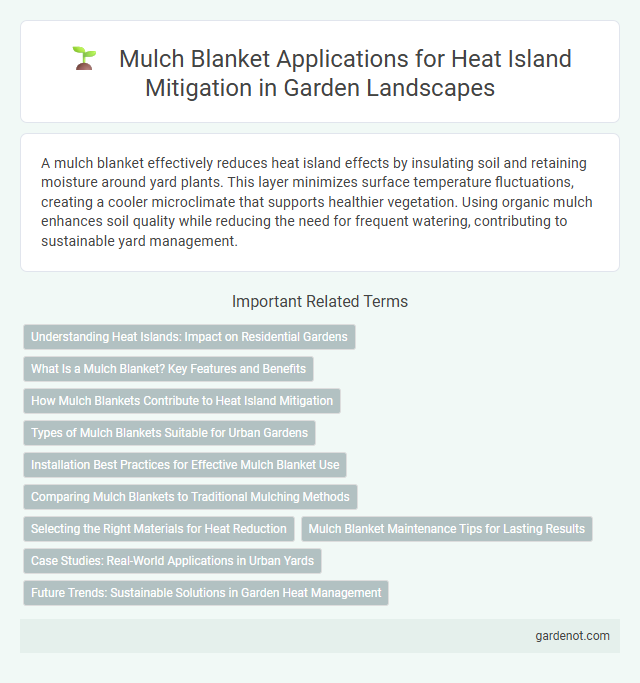A mulch blanket effectively reduces heat island effects by insulating soil and retaining moisture around yard plants. This layer minimizes surface temperature fluctuations, creating a cooler microclimate that supports healthier vegetation. Using organic mulch enhances soil quality while reducing the need for frequent watering, contributing to sustainable yard management.
Understanding Heat Islands: Impact on Residential Gardens
Mulch blankets play a crucial role in mitigating urban heat islands by regulating soil temperature and retaining moisture in residential gardens. Their insulating properties reduce surface heat absorption, helping to cool the surrounding air and promote healthier plant growth. Implementing mulch blankets can significantly lower localized temperatures and improve the microclimate in heat-affected urban yards.
What Is a Mulch Blanket? Key Features and Benefits
A mulch blanket is a protective layer of organic or synthetic material spread over soil to conserve moisture, regulate temperature, and reduce erosion in heat island mitigation yards. Key features include its ability to retain soil moisture, lower surface temperatures, and suppress weed growth, effectively reducing heat absorption by the ground. Benefits include enhanced soil health, improved plant growth, and a significant decrease in urban heat island effects by maintaining cooler yard environments.
How Mulch Blankets Contribute to Heat Island Mitigation
Mulch blankets reduce soil temperature by providing a protective layer that limits heat absorption and retains moisture, thereby lowering surface temperatures in urban heat islands. These blankets enhance soil health and promote vegetation growth, which increases evapotranspiration and further cools the surrounding environment. By minimizing bare ground exposure, mulch blankets also reduce heat radiation and improve overall urban climate resilience.
Types of Mulch Blankets Suitable for Urban Gardens
Organic mulch blankets, such as wood chips, straw, and shredded bark, are highly effective for urban garden heat island mitigation due to their moisture retention and soil temperature regulation properties. Inorganic mulch blankets, including rubber mulch and gravel, provide durable ground cover options that reduce heat absorption and minimize soil evaporation in dense city environments. Choosing the right mulch type depends on factors like local climate, plant species, and maintenance requirements to optimize urban garden cooling effects.
Installation Best Practices for Effective Mulch Blanket Use
Proper installation of mulch blankets involves preparing the soil surface by removing debris and ensuring it is moist but not saturated to promote optimal adherence. Applying the mulch blanket uniformly with overlaps of at least 3 inches prevents erosion and provides consistent coverage, enhancing heat island mitigation by maintaining soil moisture and reducing surface temperatures. Securing the blanket with biodegradable stakes or staples at intervals of 3 to 5 feet minimizes displacement from wind or rain, ensuring long-term effectiveness in urban heat reduction efforts.
Comparing Mulch Blankets to Traditional Mulching Methods
Mulch blankets offer superior heat island mitigation by providing consistent soil coverage, reducing surface temperatures more effectively than traditional loose mulch. Their durable design minimizes displacement from wind and rain, ensuring long-term moisture retention and enhanced soil protection. Compared to traditional methods, mulch blankets significantly improve vegetation establishment and reduce maintenance frequency in urban heat island environments.
Selecting the Right Materials for Heat Reduction
Choosing the right mulch blanket materials is crucial for effective heat island mitigation. Organic mulches like wood chips and bark provide natural insulation, reduce soil temperature, and retain moisture, while inorganic options such as rubber or gravel offer durability and heat deflection. Opting for light-colored or reflective mulches further enhances heat reduction by minimizing solar absorption in urban yards.
Mulch Blanket Maintenance Tips for Lasting Results
Mulch blanket maintenance includes regular inspection for signs of degradation, replenishing mulch layers to maintain effective insulation, and ensuring proper moisture levels to support soil health. Prompt removal of weeds and debris prevents competing vegetation and maintains mulch efficiency in heat island mitigation. Consistent upkeep of mulch blankets optimizes temperature regulation and enhances the durability of heat island reduction efforts.
Case Studies: Real-World Applications in Urban Yards
Mulch blankets have proven effective in heat island mitigation by reducing soil temperature and enhancing moisture retention in urban yards, as demonstrated in multiple case studies across cities like Phoenix and New York. In Phoenix, the application of organic mulch blankets resulted in a 10degF decrease in surface temperature, significantly lowering ambient heat levels. New York urban yards using mulch blankets reported improved soil health and reduced irrigation needs, showcasing mulch's role in sustainable urban landscaping.
Future Trends: Sustainable Solutions in Garden Heat Management
Mulch blankets are emerging as a sustainable solution in garden heat management by significantly reducing soil temperature and conserving moisture in urban heat island mitigation yards. Innovations in biodegradable and recycled-material mulch blankets enhance environmental impact while promoting soil health and reducing water consumption. Future trends emphasize integrating smart mulch systems with sensors to optimize thermal regulation and support resilient urban green spaces.
Mulch blanket Infographic

 gardenot.com
gardenot.com